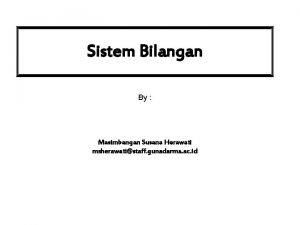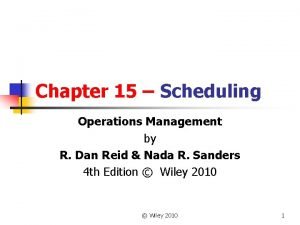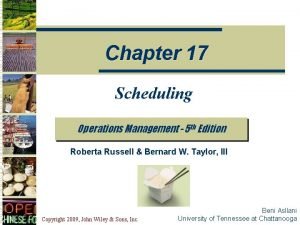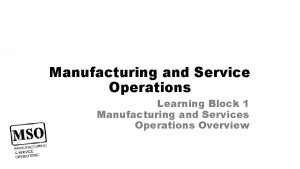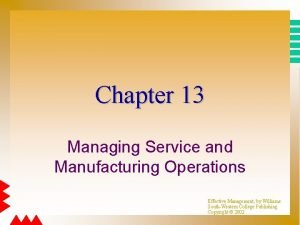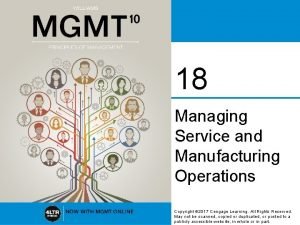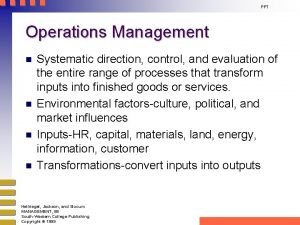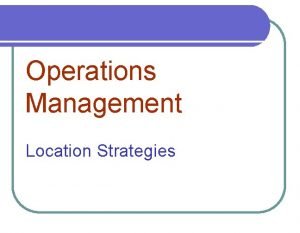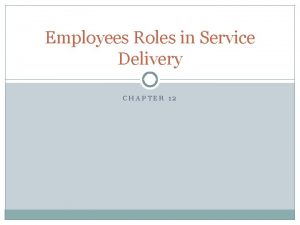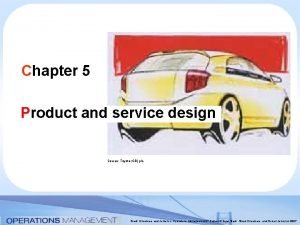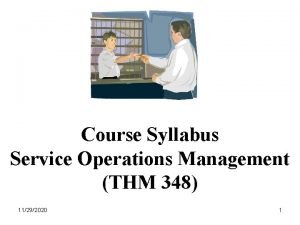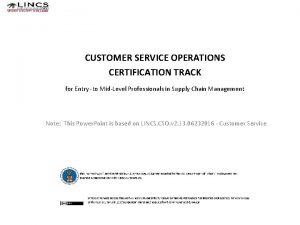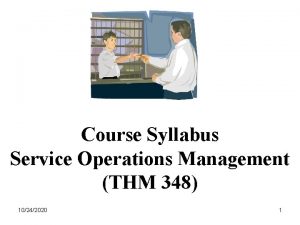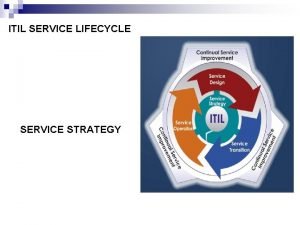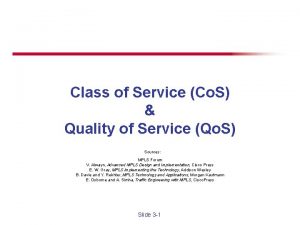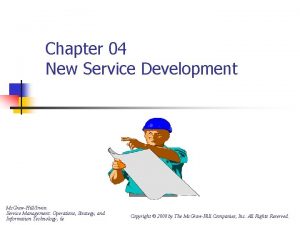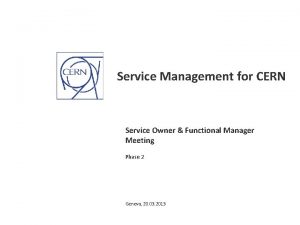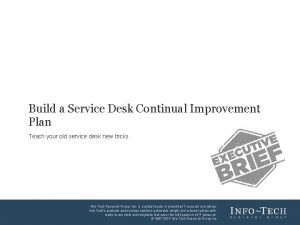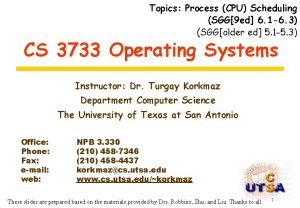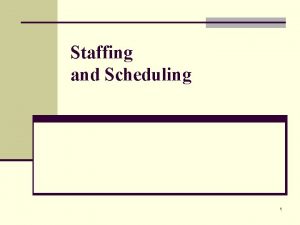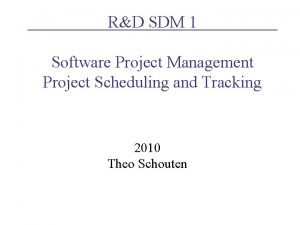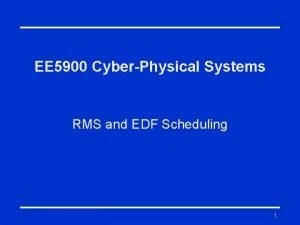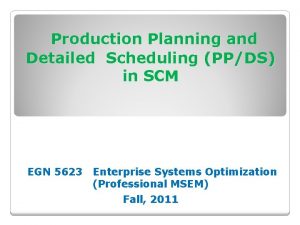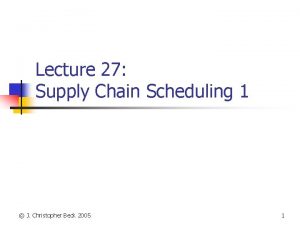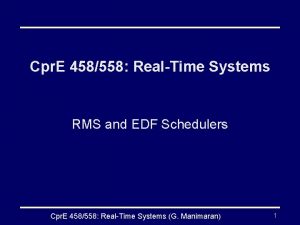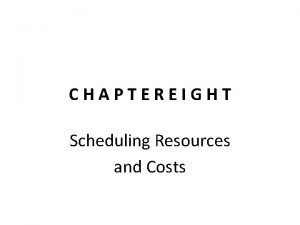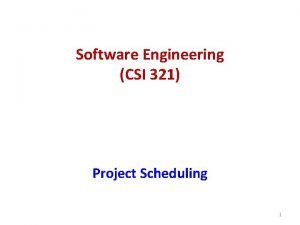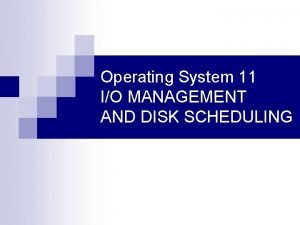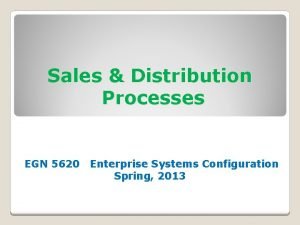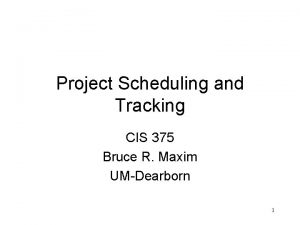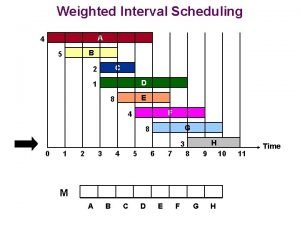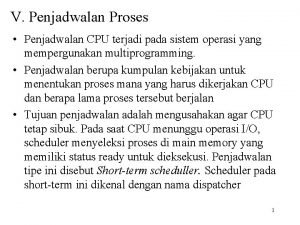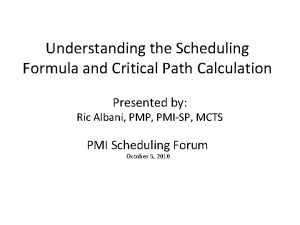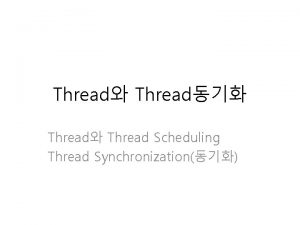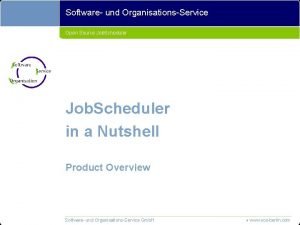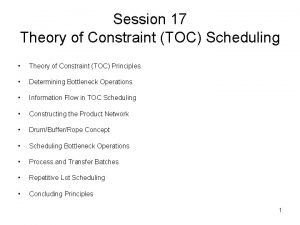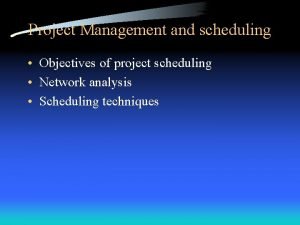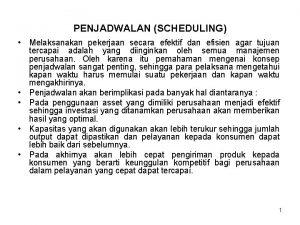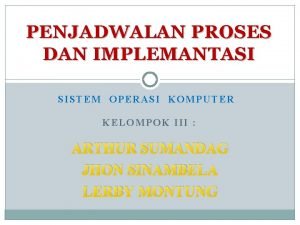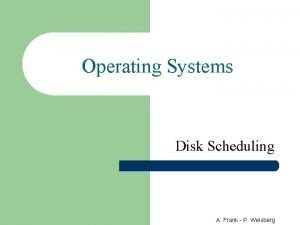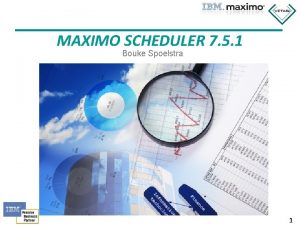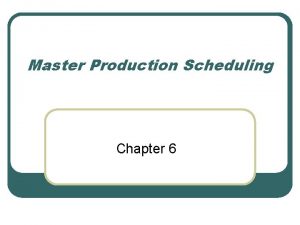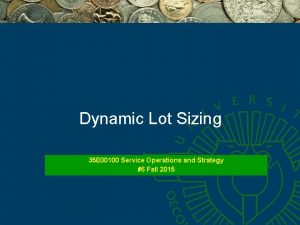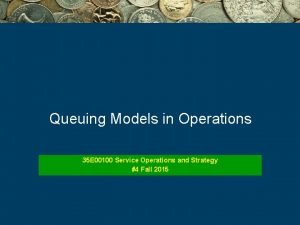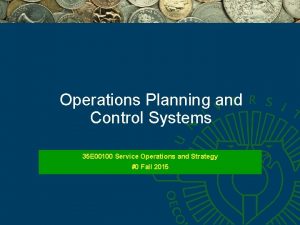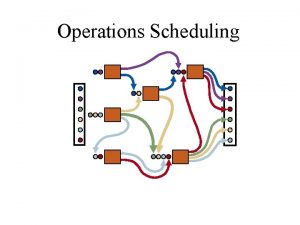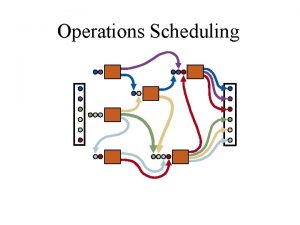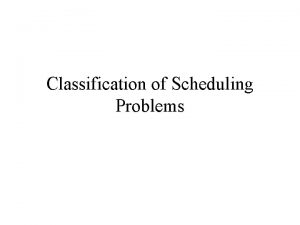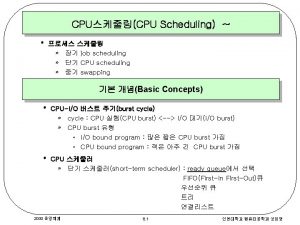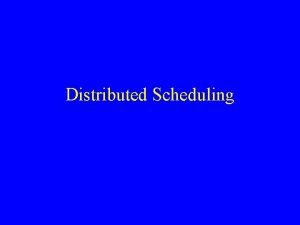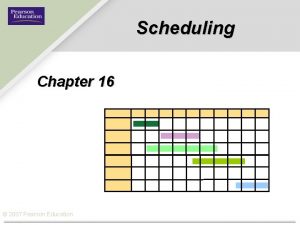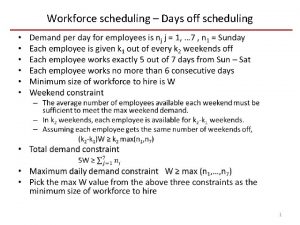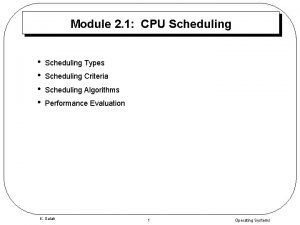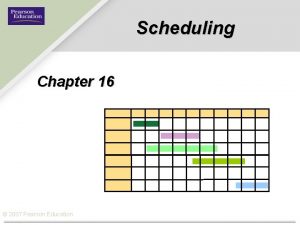Operations Scheduling 35 E 00100 Service Operations and











































































- Slides: 75

Operations Scheduling 35 E 00100 Service Operations and Strategy #5 Fall 2015

Topics Principles of scheduling n Objectives and constraints n Problem types Practices in Finnish companies Setting lead times and order priorities n Lead time quoting n Basic dispatching rules n Advances scheduling heuristics Key points Useful material in the textbook and course package: Hopp, W. & Spearman, M. (2000), Factory Physics, Chapter 15 Vepsalainen, A. & Morton, T. (1987) “Priority Rules for Job Shops with Weighted Tardiness Costs”, Management Science 35 E 00100 Service Operations and Strategy #5 2 Aalto/BIZ Logistics

Production Scheduling Principle n Concerns the allocation of limited resources to tasks over time (Pinedo, 1999). n Determines in what sequence orders are processed on available resources. Justification n Allows better matching of customer requirements and service. - e. g. response times and delivery accuracy n Supports coordination of material flows. ai ri Machine a dij pi 1 a Machine b … di 2 pi 2 b Machine k dij pijk Operation 1 Operation 2 Operation j 35 E 00100 Service Operations and Strategy #5 3 Ci di Aalto/BIZ Logistics

The Definition of Scheduling A scheduling system dynamically makes decisions about matching activities and resources in order to finish jobs and projects needing these activities in a timely and highquality fashion while simultaneously maximizing throughput and minimizing direct operating costs. (Morton & Pentico 1993, 10) Basic scheduling decisions typically include • Routing • Sequencing • Timing / release 35 E 00100 Service Operations and Strategy #5 4 Aalto/BIZ Logistics

A Two-Operations Process A Flow Shop Input 1 35 E 00100 Service Operations and Strategy #5 Buffer 2 (WIP) 5 Output Aalto/BIZ Logistics

Most scheduling environments are extremely complex. . A D B E Raw materials Finished products C F Queue 35 E 00100 Service Operations and Strategy #5 6 Decision Work center Aalto/BIZ Logistics

Types of Scheduling Models (1) Project Scheduling § Objective is to minimize total time § Unlimited number of machines § Precedence constraints critical path to be identified § Important in large multi-stage projects Job Shop Models § § Jobs with a number of operations Machine configuration / job routing One or more objectives Both manufacturing and service industries Production Systems with Automated Handling § Jobs with a number of operations § Material handling and conveyor systems control the movement of jobs and timing of their processing on various machines § Objective is to maximize throughput § Applied for example in FMS and in automotive industry 35 E 00100 Service Operations and Strategy #5 7 Aalto/BIZ Logistics

Types of Scheduling Models (2) Lot Scheduling § Medium- and long-term production planning and control § Objective is usually to minimize total inventory and changeover costs § Continuous production & demand processes § Handle a variety of different products § Process and retail industries Workforce Scheduling • Different, although often intertwined with machine scheduling Reservation and Timetabling Models § Reservation systems • Objective is to process as many jobs as possible • Starting and completion times of jobs are fixed § Timetabling models • Objective is to process all jobs and minimize makespan • Starting and completion times are not fixed • Two jobs that require same tool cannot be processed at the same time • Facility scheduling (classrooms, vehicles) 35 E 00100 Service Operations and Strategy #5 8 Aalto/BIZ Logistics

Order Management Decisions Markets / Customers Material requirements Order Demand forecasts acceptance Production planning Master scheduling Due date assignment Capacity status Material requirements planning, Capacity planning Scheduling constraints Shop orders Release dates Order release Scheduling and Rescheduling Schedule performance Schedule Order sequencing Detailed scheduling Dispatching Shop status Job loading Job dispatching Shop floor management Modified from Pinedo and Chao 1999, 7 35 E 00100 Service Operations and Strategy #5 9 Aalto/BIZ Logistics

Illustrative Examples Practices in Finnish Industrial Firms Case 1: Machinery Order processing Case 2: Metal Products Order processing n Via worldwide sales network n Via sales unit network in Europe n Cooperation between mfg and n Centralized sales support centralized sales support n Chain-wide IT integration in progress n A part of orders electronically n IT integration within the firm; there are Decision-makers n Order acceptance: sales (market) efforts to share information openly through the supply chain n Orders via fax and e-mail Decision-makers n LT estimation: sales (mill) n Order acceptance: sales (market) n Final schedule: sales and production n LT estimation: sales (market) planning n Dispatching: shop floor n Final schedule: production planning Main criteria in use n Dispatching: --- (not needed) Main criteria in use n Order acceptance: profit, relationship n Order acceptance: capacity n Lead-times: standard estimates n Schedule: delay penalties n Schedule: no priorities or penalties 35 E 00100 Service Operations and Strategy #5 10 Aalto/BIZ Logistics

Illustrative Examples Practices in Finnish Industrial Firms Case 4: Paper Case 3: Electronics Order processing n Directly to manufacturing units n Via sales units and agents n IT systems integrated partly in the n Centralized sales support chain: limited information sharing n A part of orders electronically n System integration in-progress; Decision-makers n Order acceptance: sales (mill) currently order and schedule information is shared only internally Decision-makers n Lead-time estimation: production n Order acceptance: sales (mill) planning n Final schedule: production planning n Dispatching: shop floor n Lead-time estimation: sales (mill) Main criteria in use n Order acceptance: capacity n Final schedule: sales (mill) & production planning n Dispatching: --- (not needed) Main criteria in use n Lead times: order-specific estimates n Order acceptance: capacity n Schedule: some implicit priorities, n Lead-time: standard estimates penalties occasionally considered 35 E 00100 Service Operations and Strategy #5 n Schedule: no priorities or penalties 11 Aalto/BIZ Logistics

HSE Study on Priority Scheduling and Customer Order Management · Research question – Do priority rules provide a protocol for coordinated order management? · Objectives – Identify robust and well-performing priority rules or families of such rules for order mgmt. – Examine different technical specifications and tolerances for information and communication necessary to implement the scheduling rules. – Demonstrate the sensitivity of system performance to different conventions in order handling. · The scheduling problem analyzed – Job shop problem with standard assumptions – Non-delay scheduling – Weighted tardiness problem Ø Heterogeneous lead time expectations Ø Different costs for inventory, expediting, and tardiness 35 E 00100 Service Operations and Strategy 2009 12 HSE/Logistics

Order Management and Scheduling Practices in Finnish Manufacturing · Explorative multi-case study – 16 manufacturing companies with operations in Finland – Leading players in their field Ø electrical equipment and components, heavy machinery, metal & paper · Objective – To review current intra- and inter-firm order management and scheduling practices · Data collection process – Personal interviews based on a questionnaire Ø in total about 160 questions Ø mostly structured questions – Data includes detailed descriptions on Ø organization structure and culture Ø operations within the order-delivery process and supply chain Ø firm and supply chain performance 35 E 00100 Service Operations and Strategy 2009 13 HSE/Logistics

Descriptions of the Selected 16 Cases 35 E 00100 Service Operations and Strategy 2009 14 HSE/Logistics

Categorization of Production Planning and Control Approaches Type of Logistics System Contingent Projects Job Shop Type of Production System Assembly/ Batch Line Standard Deliveries Customer-driven Planning & g in l Control du e h Sc ity r io Pr Flow Balancing in Planning & Control Capacitydriven Planning & Control Continuous Flow Production 35 E 00100 Service Operations and Strategy 2009 Routine Shipments 15 HSE/Logistics

Positioning of the 16 Cases Framework of Operational Systems Type of Logistics System Job Shop Type of Production System Assembly/ Batch Line Contingent Projects Standard Deliveries Group 1 Group 2 Case F Case H Case E Case G Group 4 Case A Case B Case C Routine Shipments Group 3 Case D Group 5 Case J Case K Case L Group 6 Case I Case M Case N Case O Case P Continuous Flow Production 35 E 00100 Service Operations and Strategy 2009 16 HSE/Logistics

Categorization of Production Scheduling Methods Objective of Scheduling Sales-oriented, Customer Requirements Adjustable Capacity Production-oriented, Productivity Requirements 1 Order-based scheduling 3 Production and materials planning 2 Sales budgeting / Capacity allocation 4 Product sequencing for capacity Constraint Fixed Capacity 35 E 00100 Service Operations and Strategy 2009 17 HSE/Logistics

A Generic Framework of Order Management Decisions (modified from Pinedo 1995) Suppliers Customers Orders Forecasts Material requirements Order acceptance Production planning, Master scheduling Due date assignment Capacity status Material requirements planning, Capacity planning Scheduling constraints Order release Shop orders Release dates Scheduling and Rescheduling Schedule performance Order sequencing Schedule Detailed scheduling Dispatching Shop status Job dispatching Job loading Shop floor management 35 E 00100 Service Operations and Strategy 2009 18 HSE/Logistics

Operations Control Framework Typical Order Management Procedures with Different Production Scheduling Methods Objective of Scheduling Production-oriented, Productivity Requirements Sales-oriented, Customer Requirements Customer orders Order acceptance Production planning, Master scheduling Adjustable Capacity 1 Orderbased scheduling Due date assignment Material requirements planning, Capacity planning Order release Scheduling, Rescheduling Order sequencing Dispatching Capacity Constraint Production planning, Master scheduling 3 Production and materials planning 35 E 00100 Service Operations and Strategy 2009 Order sequencing Dispatching Job dispatching Shop floor management Customer orders Order acceptance Production planning, Master scheduling Fixed Capacity Order release Scheduling, Rescheduling Job dispatching Order acceptance 2 Sales budgeting / Capacity allocation Due date assignment Material requirements planning, Capacity planning Order release Scheduling, Rescheduling Order sequencing 4 Product sequencing for capacity Due date assignment Material requirements planning, Capacity planning Order release Scheduling, Rescheduling Order sequencing Dispatching Job dispatching Shop floor management 19 HSE/Logistics

Positioning of the 16 Cases Framework of Scheduling Methods Objective of Scheduling Production-oriented, Productivity Requirements Sales-oriented, Customer Requirements Adjustable Capacity Constraint Fixed Capacity 1 Order-based scheduling 3 Production and material planning Case companies E, G, H, J, K, L B, C, D, F 2 Sales budgeting / Capacity allocation 4 Product sequencing for capacity Case companies I, M, P A, N, O 35 E 00100 Service Operations and Strategy 2009 20 HSE/Logistics

Positioning of the 16 Cases Decision-makers in Order Management Decision Lead-time estimation Order acceptance Final production schedule H Sales organization Sales at mill Decision-making Responsibility Production planning at mill H E I F D O G O A K K I D P M J L P B N J L P M C E B N C G O F L A B N D G M K I A C F E H Order-based scheduling Shop floor management Production and materials planning Sales budgeting / Capacity allocation J Product sequencing for capacity 35 E 00100 Service Operations and Strategy 2009 21 HSE/Logistics

Characteristics of Scheduling Models Machine Configurations Single-Machine Models Single bottleneck in a multiplemachine environment Parallel-Machine Models Single stage with a number of machines in parallel n Bottleneck determines the schedule n Jobs can be processed on any one of n Up- and downstream operations available machines n Important for the same reason as the single-machine model: one workcenter may determine the performance of an entire system scheduled after the bottleneck Reduction of the problem or a decomposition approach Optimal solutions can be found e. g. by applying dispatching rules n EDD, SPT Machines are not necessarily identical n e. g. skills of operators, machine age n Specific subsets 35 E 00100 Service Operations and Strategy #5 22 Aalto/BIZ Logistics

Characteristics of Scheduling Models Typical Production Environments Flow Shop Models Job Shop Models Routes of all jobs are identical Different routings are possible n Machines set up in a series n Jobs can visit a machine either once or several times n Jobs do not need to be processed on every machine n Whenever completed a job joins the queue of the next machine n Job sequence may vary due to resequencing between machines Models can be extremely complex! Some flow shops allow bypassing of machines Generalization: flexible flow shop 35 E 00100 Service Operations and Strategy #5 23 Aalto/BIZ Logistics

Illustrations of Flow Shop and Job Shop Flow Shop Manufacturing a i ri Machine a i pi 1 a Machine b dij pi 2 b Operation 1 di 2 Ci Machine k … pijk Operation 2 dij di Operation j Job Shop Manufacturing Machine c pijc Machine f pijf ai ri Ci Machine a di pija Machine d pijd Machine b pijb 35 E 00100 Service Operations and Strategy 2009 24 HSE/Logistics

Service-Related Performance Measures Processing time related objectives n Throughput is determined by the output rate of the bottleneck machine. - Ensure that the bottleneck machine is never idle (jobs in queue) - Sequence jobs so that the sum of setup times or average setup time is minimized n Makespan is the total processing time of a set of jobs. - Important, if the number of jobs is finite Due date related objectives n Lateness n Number of tardy jobs n Average tardiness Measure the level of customer service and external efficiency Weighted versions of indicators can be used. 35 E 00100 Service Operations and Strategy #5 25 e. g. Hopp and Spearman 2000, 489 Aalto/BIZ Logistics

Measures on the Fulfillment of Confirmed Delivery Dates Service level Lateness n MTO systems n Shop floor control n The part of orders, which n Difference between due is produced/delivered by given due dates. date and completion date n Variance of lateness Fill rate ( service level) Tardiness n MTS systems n Shop floor control n The part of demand, n If job is late same as which is fulfilled from the stock without shortage 35 E 00100 Service Operations and Strategy #5 lateness, otherwise 0 n Important measure for the average delay 26 e. g. Hopp and Spearman 2000, 489 Aalto/BIZ Logistics

Due Date Related Measures Li Cost function in practice Ci di The lateness Li of job i Ti di di The tardiness Ti of job i 35 E 00100 Service Operations and Strategy #5 Ci 27 Ci Ci = completion time of job I di = due date of job i Aalto/BIZ Logistics

Cost-Based Performance Measures Setup costs n Measures: total setup time, average setup time, total machine idle time n Minimizing often pays off, if the goal is to maximize throughput and minimize makespan n Not necessarily proportional to setup times Work-in-process inventory costs n WIP ties capital, increases handling costs n Older WIP easily becomes damaged, etc. n Measure surrogating WIP is average throughput time (~avg # of jobs) Finished goods inventory costs n In MTO, earliness costs n In MTS, depends on setup and holding costs Personnel costs n Regular overtime costs Other measures: earliness, schedule robustness 35 E 00100 Service Operations and Strategy #5 28 Aalto/BIZ Logistics

Best-Known Problem Types Minimizing average cycle time on a single machine Minimizing average tardiness on a single machine n Total time to complete all jobs does not depend on the ordering n Apply SPT rule not depend on the ordering n No sequencing rule is guaranteed to minimize this measure (NP hard problem) n EDD is often a good heuristic Minimizing maximum lateness on a single machine n Total time to complete all jobs does not depend on the ordering n Sequence the jobs according their due dates = Apply EDD rule n Intuitive solution 35 E 00100 Service Operations and Strategy #5 Minimizing makespan on two machines n Makespan no longer fixed but sequence dependent n Certain schedules might induce idle time n A simple algorithm proposed by Johnson (1954) 29 e. g. Hopp and Spearman 2000, 492 -493 Aalto/BIZ Logistics

Classic Scheduling Problems One-, two- or three-machine problems Several simplifying assumptions n All jobs are available at the start of the problem (no jobs arrive n n n after processing begins) Process times are deterministic Process times do not depend on the schedule (no setups) Machines never break down No preemption: once a job starts processing it must finish Jobs are not cancelled Why? n To reduce the problem to manageable proportions n To allow restriction of attention to simplified schedules and sequences 35 E 00100 Service Operations and Strategy #5 30 e. g. Hopp and Spearman 2000, 451 Aalto/BIZ Logistics

Basic Dispatching Rules FCFS, FIFO (first-in-first-out) n The order of arrival determines the sequence SPT (shortest processing time) n The shortest job first n Minimizes average processing time LPT (longest processing time) n The longest job first EDD (earliest due date) n Schedule prepared based on due dates n Job with the closest due date first n Minimizes maximum lateness ERD (earliest release date) n Similar to the EDD rule n In a sense minimizes waiting time 35 E 00100 Service Operations and Strategy #5 CR (critical ratio) n Ratio calculated by dividing time remaining with work remaining n Process 1 st the job with the smallest value n When on-time, prioritizes jobs with long processing time n When delayd, prioritizes short jobs (removes congestion) Other rules n SIRO = service in random order n WSPT = weighted SPT n MS = minimum slack n LWR = least work remaining n FOR = fewest operations remaining n LNS = largest number of successors n SQNO = shortest operation at next queue n SST = shortest setup time 31 Aalto/BIZ Logistics

Example 2 Basic Sequencing Rules Test Setting 1 machine n Empty at the beginning; No set-ups 5 jobs n Release time: n Weight: 0 for all jobs N/A 4 rules tested 4 performance measures n Mean flow time, Maximum tardiness, Average tardiness, Number of tardy jobs 35 E 00100 Service Operations and Strategy #5 32 Aalto/BIZ Logistics

Example 2 Schedule and Performance First Come First Served (FCFS) Mean flow time Average tardiness Number of tardy jobs 35 E 00100 Service Operations and Strategy #5 268/5 = 53. 6 121/5 = 24. 2 3 33 Aalto/BIZ Logistics

Example 2 Schedule and Performance Shortest Processing Time (SPT) Mean flow time Average tardiness Number of tardy jobs 35 E 00100 Service Operations and Strategy #5 135/5 = 27. 0 43/5 = 8. 6 1 34 Aalto/BIZ Logistics

Example 2 Schedule and Performance Earliest Due Date (EDD) Mean flow time Average tardiness Number of tardy jobs 35 E 00100 Service Operations and Strategy #5 235/5 = 47. 0 33/5 = 6. 6 4 35 Aalto/BIZ Logistics

Example 2 Schedule and Performance Critical Ratio (CR) Mean flow time Average tardiness Number of tardy jobs 35 E 00100 Service Operations and Strategy #5 289/5 = 57. 8 87/5 = 17. 4 4 36 Aalto/BIZ Logistics

Example 2 A Comparison of the Schedules Measures = makespan = maximum tardiness = number of tardy jobs = total flow time = total tardiness = total weighted flow time = total weighted tardiness Avg flow time 35 E 00100 Service Operations and Strategy #5 37 Avg tardiness 57. 8 17. 4 47. 0 6. 6 53. 6 24. 2 27. 0 8. 6 Aalto/BIZ Logistics

Different Types of Priority Rules Dynamic rules (vs. static) n Indices recalculated every time machine is loaded n Examples - CR (slack per remaining processing time pi) - S/RO (slack per number of remaining operations) - MOD (modified due date): Same principle as in EDD but a modified due date d’ = Max (di, t+pi) is used Composite rules n Additive rules - A ranking expression that combines basic dispatching rules - Each basic rule has own scaling parameter n Heuristics - Combine good characteristics of basic rules - ATC (apparent tardiness cost) - COVERT (cost over time) 35 E 00100 Service Operations and Strategy #5 38 Aalto/BIZ Logistics

The Difficulty of Scheduling Problems Many problems too “hard” for finding optimal solutions n Class P: a polynomial solution exists n Class NP: no polynomial solution n Sequencing problems grow as n! Computation times n How many jobs can we sequence optimally if - The computer can examine 1 000 sequences per second - The response time of the scheduling system should be no longer than one minute? n What if the capacity of the computer is 1000 times faster Polynomial algorithms can be used to obtain “good” solutions n E. g. Simulated annealing, Tabu search, Genetic algorithms 35 E 00100 Service Operations and Strategy #5 39 Aalto/BIZ Logistics

Motivation for Improved Scheduling · Major changes in production – Creeping networking and differentiation of roles Ø Outsourcing increases the number of supply chain players involved Ø Distances among decision-makers increase Ø More uncertainty and variability – Ever-increasing global competition Ø Higher expectations for response times Ø Pressure to improve cost efficiency Ø Less slack in lead times, inventories, and capacities · Advances in information systems – Increasing computing power – More sophisticated IT systems Ø Use of planning and scheduling techniques Ø Integration of inter-organizational systems – Lack of real-life applications & proven benefits, yet high expenses 35 E 00100 Service Operations and Strategy 2009 40 HSE/Logistics

The Fundamental Issue in Order Handling · Which customer order is given a priority when… – Production capacity and/or material are limited? – Disturbances occur due to machinery problems or transport schedules? – Only some customer orders can be delivered fast? · How the value and price of the customer service offered is defined and communicated? – Who takes the responsibility of the operating model before one must? – What are the expected business benefits? – How does the customer gain? · If you don’t measure, you can’t manage… – Can you really manage complicated scheduling tasks without measuring (or estimating) even the most relevant details of success? 35 E 00100 Service Operations and Strategy 2009 41 HSE/Logistics

Research on Scheduling Problems Has Been Fragmented A classification of research by Jain & Meeran (1999, 393): 35 E 00100 Service Operations and Strategy 2009 42 HSE/Logistics

Researchers have focused on designing yet another dispatching rule Dynamic pricing & due date mgmt Optimal due ? ? ? date quoting Number of articles per decade Selective order Versatile rule testing acceptance Priority classes & pricing Simple rules Composite rules IJIE MS IJPR 1960 1970 35 E 00100 Service Operations and Strategy 2009 Weighted criteria OR NRLQ MS IJPR Intelligent heuristics Parametric analyses Omega JORS IIE Transactions JOM MS IJPR 1980 43 60 Agent-based reasoning Lead-time estimation Order release mechanism 80 1990 DS POM IIE Transactions Comps. OR IJPE IJOPM PPC EJOR IJPR 40 Comps. OR JORS PPC EJOR IJPR 20 Major publication outlets 2000 HSE/Logistics

How many rules must a scholar - or a manager - know? There are over 300 dispatching rules defined in literature, perhaps 120 rules if you exclude situational variants – but mere 35 rules seem to span the whole scope of dispatching tasks. 35 E 00100 Service Operations and Strategy 2009 44 HSE/Logistics

Key Questions on Tardiness Rules · Why aren’t there business cases that one could learn from? – researchers have developed ever new rules for different types of problems – not much academic glory in proving some rules useful – managers have found most scheduling methods rather complicated to use, even to understand – half-hearted attempts are doomed – some more advanced applications tend to be proprietary and limited to corporate-specific problems · What priority rules are available in commercial planning and scheduling software? – usually only the simple rules (FIFO, EDD, SPT) are readily defined – managerial commitment required for appropriate data & use · What would it take to utilize the best rules in practice? – definition and use of an Order Scheduling Protocol – minor adjustments in the information systems and relationship management 35 E 00100 Service Operations and Strategy 2009 45 HSE/Logistics

Open Questions · What does a delayed delivery of an order to a customer really cost? Which company will be the first one to know? · Who knows how long it takes to fulfill an order in a given business situation? How much would we gain from being able to predict order fulfillment times of different customer requests? 35 E 00100 Service Operations and Strategy 2009 46 HSE/Logistics

Theoretical Background Literature on Job Shop Scheduling · Research on scheduling problems has been fragmented – Researchers have focused on designing yet another dispatching rule – How many rules of the 300 must a manager know? One family of rules suffices! · Classic scheduling books – Carroll 1965, Conway et al. 1967, Baker 1974, French 1982, Morton and Pentico 1993, Pinedo 1995. · Surveys of dispatching rules – Panwalkar & Iskander 1977, Blackstone et al. 1982, Haupt 1989, Ramasesh 1990. · Key publications on the weighted tardiness problem – Vepsalainen & Morton 1987 Ø Use of Apparent Tardiness Cost (ATC) rule in job shop environment Ø Normalized performance measures and tardiness penalty as a key job attribute. – Anderson & Nyirenda 1990 Ø Two new combination rules (CR+SPT and S/RPT+SPT). – Kutanoglu & Sabuncuoglu 1999 Ø Comparison of the weighted priority index rules, use of inserted idleness, and resource pricing with the ATC rule. – Jaymohan & Rajendran 2004 Ø Use of both holding cost and tardiness penalty as order-specific weight information. Ø Introduces a variety of new weighted composite rules. 35 E 00100 Service Operations and Strategy 2009 47 HSE/Logistics

Is it possible to achieve all the goals of scheduling. . . All at the same time? 1. High utilization - low unit costs and 2. On-time deliveries of important orders - premium service and 3. Fast throughput of all orders - low inventory levels and 4. Robust operations that are tolerant to faults - managerial errors in cost and processing time data and - disruptions in ordering and production process ? Yes – Provided there is a commitment to the Value of On-Time Delivery and a rational look-ahead rule. 35 E 00100 Service Operations and Strategy 2009 48 HSE/Logistics

The most important orders are delivered on-time if an appropriate rule is used EDD 5 x 3 x 2 x 50% 80% 35 E 00100 Service Operations and Strategy 2009 Look-ahead rules 90% 49 HSE/Logistics

All orders flow through quickly if an appropriate rule is used. Look-ahead rules (ATC, COVERT & CR+SPT) 35 E 00100 Service Operations and Strategy 2009 50 HSE/Logistics

Errors in order data can be managed if an appropriate rule is used. 35 E 00100 Service Operations and Strategy 2009 51 HSE/Logistics

Properties of the Look-ahead Rules · ATC has a natural approximation of look-ahead – First day steep, second less, then linear. – Local look-ahead is easier to use. – Decision-makers benefit from the possible interpretation of cost index values. · COVERT misses operation due dates – Not a crucial limitation for one-stage operations. · CR+SPT simple but hard to interpret and apply in practice? 35 E 00100 Service Operations and Strategy 2009 52 HSE/Logistics

The Logic of Apparent Tardiness Cost Rule Priority index value ATC: Lookahead t 35 E 00100 Service Operations and Strategy 2009 53 HSE/Logistics

The priority index of Apparent Tardiness Cost (ATC) rule Priority index value ATC index: Two jobs: a (two operations) b (one operation) ATC t 35 E 00100 Service Operations and Strategy 2009 54 HSE/Logistics

The logic of look-ahead rules such as Apparent Tardiness Cost and COVERT and CR+SPT ATC: Priority index value COVERT: CR+SPT: CR+SPT COVERT ATC COVERT t 35 E 00100 Service Operations and Strategy 2009 55 HSE/Logistics

An Illustrative Example – Final Sequencing Five Orders for Product Y (delay penalty=1) Confirmed delivery date to the customer (POD) Order data Order quantity Processing. Transport time (hrs) time (days) Due date # Arrival time 1. 2. 3. 4. 5. 29. 9. 30. 9. 1. 10. 2. 10. 750 850 225 550 200 4. 0 5. 0 1. 0 2. 0 13. 10. 12. 10. 14. 10. 15. 10. 16. 10. 2 1 3 4 5 (at customer) OTDV (delay penalty) 1 1 1 Production scheduling decisions – – Post Goods Issue (PGI) date (Scheduled Finish Date is – 1 day) Ex works due date 11. 10. ‘Due date’–‘transport time’ e. g. 15. 10 – 4 days Decisions are made on Oct 11, 7: 00 AM. 2 production cells are available for total of 5+5=10 hrs work. There is material for each of the orders. If an order is not ready by 12. 00 PM, it may arrive late to the customer. In what sequence the orders should be made? 35 E 00100 Service Operations and Strategy 2009 56 HSE/Logistics

An Illustrative Example – Final Sequencing with OTDV=1 Performance in the Example Order data # Arrival time Order Processing Transport quantity time (hrs) time (days) (at customer) 1. 2. 3. 4. 5. 29. 9. 30. 9. 1. 10. 2. 10. 750 850 225 550 200 13. 10. 12. 10. 14. 10. 15. 10. 16. 10. 4. 0 5. 0 1. 0 2 1 3 4 5 Due date OTDV (delay penalty) 1 1 1 Ex works due date 11. 10. Using the EDD (=earliest due date) rule may not differentiate orders in the final sequencing. Results with different principles/rules – – – #, %TJ avg. Tard 2, 40% (4 -14: 00, 5 -14: 00) 0. 8 2, 40% (1 -13: 00, 2 -15: 00) 0. 8 3, 60% (4 -13: 00, 3 -13: 00, 5 -15: 00) 1. 0 2, 40% (1 -13: 00, 2 -15: 00) 0. 8 3, 60% (4 -13: 00, 5 -14: 00, 3 -14: 00) 1. 0 Earliest arrival time first: Smallest order quantity first: Largest order quantity first: Shortest processing time first: Largest processing time first: What other criteria (or performance measure) could be used? 35 E 00100 Service Operations and Strategy 2009 57 HSE/Logistics

An Illustrative Example – Final Sequencing with Different Values for OTD Reduction rate per 3 slack hours 1. 0, 0. 7, ½, ⅓, ¼, … Order data Consider also ‘weighted SPT’ & ‘highest penalty first’. # Arrival time Order quantity 1. 2. 3. 4. 5. 29. 9. 30. 9. 1. 10. 2. 10. 750 850 225 550 200 Processing Transport time (hrs) time (days) 4. 0 5. 0 1. 0 2 1 3 4 5 Due date OTDV (at customer) (delay penalty) 13. 10. 12. 10. 14. 10. 15. 10. 16. 10. 1 10 2 5 20 Ex works due date 11. 10. OTD index (TAF*OTDV/PT) 1. 0*1/4 =. 25 1. 0*10/5= 2. 0 0. 7*2/1= 1. 4 0. 7*5/2= 1. 75 0. 7*20/2=7. 0 Results with different principles/rules – – – Earliest arrival time first: Smallest order quantity first: Largest order quantity first: Shortest processing time first: Largest processing time first: %TJ 40% tardy 40% 60% avg weighted tardiness 10. 0 6. 2 9. 4 6. 2 10. 0 (or 6. 2 if #5 before #4) Look-ahead OTD: 20% tardy, average weighted tardiness less than 0. 1 - it gets the job 58(and jobs) done optimally! 35 E 00100 Service Operations and Strategy 2009 HSE/Logistics

Three Parts of the OTD rule (=ATC rule) Every order has three factors, which are necessary to establish consistent and rational expectations of the true value of on-time deliveries and reliable lead time estimates, and thereby use them accurately for marketing and internal incentives 1. Processing Time (PT) 2. On-time Delivery Value (OTDV) = cost of being tardy 3. Tardiness Anticipation Factor (TAF) = f(slack) = f(due date - current date - processing time). (This factor increases from 0 to 1 as slack is reduced). / The OTD index = (OTDV PT) x TAF x slack €/time unit Notice: Waiting time estimates are needed for estimation of slack and evaluation of lead times (also in a one-stage problem) 35 E 00100 Service Operations and Strategy 2009 59 HSE/Logistics

On-time Delivery Value of an Order – What does a delayed delivery of an order to a customer really cost? · Extra costs to the customer caused by lack of product and/or expediting and hustle (increased transaction costs). – 5 -20% of the value of the order -- € 100. . 1000/day + € 10. . 300/day · Late / tardy shipment causes harm and bad-will to the customer. – 0 -500% of the value of the order -- € 10. . 10 000/day (probability equivalent) · OTDV depends on the importance and size of the order, and the number of hours or days tardy. What about lead time? – What we mean by that? - Weight is constant w/ linear aggregate value · Severity of tardiness of an order may increase OTDV as time progresses: – – Being late from the promised delivery date is a major problem. Potential cancellation of the customer order – probability increases? Inventory replenishment may have gradually increasing urgency. Pushing the standard processing and waiting times, including transfers, extra packaging etc. expediting costs, and the cost of faster transportation. 35 E 00100 Service Operations and Strategy 2009 60 HSE/Logistics

The Good News Due dates - We can set those! Job splitting n We can get smaller jobs by splitting larger ones. - Single-machine SPT results imply small jobs “clear out” more quickly than larger jobs. - Mechanics of Johnson’s algorithm implies we should start with a small job and end with a small job. - Small jobs make for small “move” batches and can be combined to form larger “process” batches. Feasible schedules n We do not need to find an optimal schedule, only good & feasible Focus on bottleneck n We can often concentrate on scheduling the bottleneck process, which simplifies problem closer to a single machine case. Capacity management n Capacity can be adjusted dynamically (overtime, floating workers, use of vendors, etc. ) to adapt facility (somewhat) to schedule 35 E 00100 Service Operations and Strategy #5 61 Aalto/BIZ Logistics

Challenges of Some Advices Given for Order Management and Scheduling How do you know when to switch from one rule type to another? 100 % 80 % Capacity Utilization Processing time based rules How to convince customers that lead times should be determined based on the work content of order? Processing time based rules Due date based rules Job A [1] C O N Time Constant (value 10) Job B [3] Job C [9] Job A [1] T W K Total work content (multiplier 3) Job B [3] Job C [9] Lead time estimate 35 E 00100 Service Operations and Strategy 2009 62 Due date HSE/Logistics

Lead Times and Rescheduling Methods for estimating manufacturing lead times n CON (constant) - No separation between orders n SLK (slack) - Time allowance with equal waiting time or slack - di = ai+ pi + fixed slack n TWK (total work) - A multiple of the processing time - di = ai + bpi Dynamic due date maintenance n Can reduce total inventory level and simultaneously improve customer service n Requires more efforts n Risks? Filters of rescheduling decision n Ability filters - Only attainable due date adjustments n Magnitude filters n Priority-based - Dynamic - Waiting time proportional to relevant queue length - Threshold value = absolute value of the difference between the new and the old due date n Horizon filters n Iteration-based - Filter out due date changes too far out in the planning horizon to be of immediate concern - Heuristic procedure 35 E 00100 Service Operations and Strategy #5 63 Partly from Vepsalainen & Morton 1988 Aalto/BIZ Logistics

Due Date Quoting New job c “Emergency” positions Rate Out r. P , s Backlog b WIP w Completed Time when the new job will be filled: m=w+b+c Hopp and Spearman 2000, 510 -513 35 E 00100 Service Operations and Strategy #5 64 Aalto/BIZ Logistics

Characteristics of Scheduling Models Processing Constraints Routing Constraints § Specify the route a job takes through a system Precedence Constraints § A job can be started only after a given set of other jobs has been completed § Precedence constraint graph may have a specific structure Machine-Eligibility Constraints § Jobs sometimes have to be processed on a specified subset of parallel machines Tooling Constraints and Resource constraints Material Handling Constraints § Refer to systems that convey jobs from one workcenter to another § Depend on the automization of workcenters: if highly automated (roboticized), processing times are deterministic § Often limit the amount of buffer space WIP level 35 E 00100 Service Operations and Strategy #5 § e. g. training of operator Personnel Scheduling Constraints § e. g. consecutive days off, shift types 65 Aalto/BIZ Logistics

Characteristics of Scheduling Models Processing Characteristics Sequence-Dependent Setup Times and Costs Order Quantity Limits and Due Dates In MTS environment - Jobs do not have tight due dates - Inventory level triggers production of stocked items - Amount produced depends on setup costs and inventory holding costs In MTO environment - Jobs have specific due dates - Quantities determined by customer § Reconfiguration or cleaning of a machine; known as setup or changeover § The length of a setup depends on the job just completed and on the one to be started Preemptions § Take place for example due to breakdown or an arrival of high priority order § Different forms - Preemptive resume (work not lost) - Preemptive repeat ( work lost) MTO and MTS often combined 35 E 00100 Service Operations and Strategy #5 66 Aalto/BIZ Logistics

Trade-off Curves in Job Shop Environments Idle time Current system Improved system Work-in-process 35 E 00100 Service Operations and Strategy #5 67 Aalto/BIZ Logistics

Order Management Protocols · Justification of open protocols – Increasing networking calls for integrative methods within one company and across independent players: Ø Centralized decision-making – by whom? Ø Real-time response - how? – Could simple standardized protocol be more efficient than customized ones? Ø Order management would be less expensive via protocols that are available to all potential users. Rationale of open protocols – Coordination of decentralized, postponed and localized decision-making – Ease of use and accessibility · Suggested three layers of protocols – Rules of scheduling behavior – Technical specifications and tolerances – Conventions of usage 35 E 00100 Service Operations and Strategy 2009 68 HSE/Logistics

Layers of an Order Management Protocol Screening rule – who, when, how Release rule – who, when, how Sequencing rule – who, when, how Conventions of usage OTD rule helps in estimating lead times, OTDVs and relative importance of orders. Scheduling rule Data tables for OTDV, TAF index, and lead time estimates Technical specifications and tolerances 35 E 00100 Service Operations and Strategy 2009 69 HSE/Logistics

The Order Management Protocol for the On-Time Delivery Rule (OTD Rule) 1. Rules of scheduling behavior – Prefer look-ahead rules, especially decomposable ATC-rule 2. Technical specifications and tolerances – Many lead time estimation methods work, esp. w/look-ahead rules – Moderate errors in the cost data and processing times estimates do not impact the ranking of the rules. – Rough-cut priority classes can improve shop performance compared to not using any method but performance is still significantly worse than with the look-ahead rules. – Data aggregation has limited benefits for most of the rules. 3. Conventions of usage – Priority rules can substitute for order release mechanisms – The look-ahead rules improve tardiness performance of production systems, even if applied at one stage only. – Predictability of tardiness behavior of orders over operations is easier with some given priority rules. 35 E 00100 Service Operations and Strategy 2009 70 HSE/Logistics

Business Potential of the Order Management Protocol and the OTD Rule · Streamlines the process – Focus on the important issues – it is not necessary to maintain all options – The real bottlenecks will be revealed and resources aligned · Helps to learn the value of OTD to customers and fulfill your promises – Develop customer relationships and sales – Define and follow supplier contracts more accurately – Design rational basis for a market-driven incentive system · Enables the differentiation of service for satisfaction and better price – – Implementation requires training and minor changes in information system Running is free! Savings in personnel and shipping costs Enables Premium service w/o building new capacity 35 E 00100 Service Operations and Strategy 2009 71 HSE/Logistics

Using Order Priorities within Customer Order Management Process Special indications from the sales / supply team. Orders are anonymous. Sales Office Manufacturing and Logistics Operations Supply Team OTD Capacity Order Allocation & Demand-Supply acceptance. Balancing Customer service Demand peaks at the beginning of the week and at the end of period/quarter. Material requirements planning & supply mgmt Order. Scheduling & Re-scheduling release Capacity allocations weekly: remaining (frame blocks) is released later. The number of rush orders increases by the end of period/ quarter. Dispatching & Shop floor management Packaging & Final Shipping Sequencin g Transport & final delivery Factories are given the workload. MTO is a must! Expedited deliveries paid by the client Suppliers, Subcontractors, Partners and Logistics Service Providers 35 E 00100 Service Operations and Strategy 2009 72 HSE/Logistics

Main Challenges and Risks Can you accept the following? 1. Orders are different, situations / business cases are different. Different lead times 2. Some orders should go faster. Would you trust simple rules? 3. Control parameters & performance criteria can (and should) be quantified. How else differentiate the service? How else communicate the time value of an order? How to manage if you can’t measure? ! 35 E 00100 Service Operations and Strategy 2009 73 HSE/Logistics

Key Points Scheduling is challenging! Scheduling can be simplified n Flow simplification (sequencing in place of scheduling) n Due date quoting Priority scheduling n Easy to understand n Flexible and perhaps not as myopic as claimed Finite capacity scheduling will emerge 35 E 00100 Service Operations and Strategy #5 74 Aalto/BIZ Logistics

Notation and Abbreviations Used ATC = apparent tardiness cost COVERT = cost over time EDD FCFS FMS MTO MTS SPT WSPT 35 E 00100 Service Operations and Strategy #5 75 = earliest due date = first come first served = flexible mgg system = make to stock = shortest processing time = weighted SPT Aalto/BIZ Logistics
 Bilangan desimal dari 2/5 adalah
Bilangan desimal dari 2/5 adalah Job scheduling vs process scheduling
Job scheduling vs process scheduling Scheduling process-focused facilities
Scheduling process-focused facilities Operations scheduling definition
Operations scheduling definition Loading in operations management
Loading in operations management Commercial and non commercial food service
Commercial and non commercial food service Product and service design
Product and service design Difference between manufacturing and service operations
Difference between manufacturing and service operations Food and beverage preparation service management
Food and beverage preparation service management Managing service and manufacturing operations
Managing service and manufacturing operations Managing service and manufacturing operations
Managing service and manufacturing operations Perceived service alternatives
Perceived service alternatives Service provider and service consumer
Service provider and service consumer Production planning inventory control
Production planning inventory control Service operations management ppt
Service operations management ppt Service location strategy in operations management
Service location strategy in operations management Fundamentals of food and beverage service operation
Fundamentals of food and beverage service operation Roles of employees in service delivery
Roles of employees in service delivery Service design melbourne slack
Service design melbourne slack Service operations management syllabus
Service operations management syllabus Customer service operations certification
Customer service operations certification Operations management course syllabus
Operations management course syllabus Service v model
Service v model Itil five stages
Itil five stages Itil 7 step improvement process
Itil 7 step improvement process Class of service vs quality of service
Class of service vs quality of service Prepare a service blueprint for 100 yen sushi
Prepare a service blueprint for 100 yen sushi Service owner vs service manager
Service owner vs service manager Service improvement plan for service desk
Service improvement plan for service desk Adp employee self service portal
Adp employee self service portal Difference between preemptive and nonpreemptive scheduling
Difference between preemptive and nonpreemptive scheduling Staffing and scheduling
Staffing and scheduling What are the impacts of resource constrained scheduling
What are the impacts of resource constrained scheduling Sdm in project management
Sdm in project management Difference between preemptive and nonpreemptive scheduling
Difference between preemptive and nonpreemptive scheduling Backward scheduling
Backward scheduling Rms edf
Rms edf Alap
Alap Media scheduling based on flighting
Media scheduling based on flighting Principles of good routing and scheduling
Principles of good routing and scheduling Production planning and detailed scheduling services
Production planning and detailed scheduling services Scheduling and planning
Scheduling and planning Compartmentalization interdependency effort validation r
Compartmentalization interdependency effort validation r Alap
Alap Rms and edf scheduling example
Rms and edf scheduling example Scheduling resources and costs
Scheduling resources and costs Pulsing media schedule example
Pulsing media schedule example Project scheduling in software engineering
Project scheduling in software engineering Resource allocation and scheduling
Resource allocation and scheduling When the process issues and io request
When the process issues and io request Disaggregate planning
Disaggregate planning Forward and backward scheduling in sap sd
Forward and backward scheduling in sap sd Project scheduling and tracking software quality assurance
Project scheduling and tracking software quality assurance Weighted interval scheduling
Weighted interval scheduling Time sharing
Time sharing Critical path formula
Critical path formula Thread scheduling
Thread scheduling Open source job scheduler software for windows
Open source job scheduler software for windows Toc scheduling
Toc scheduling Scheduling elements casino
Scheduling elements casino Script breakdown software
Script breakdown software Mlfq scheduling
Mlfq scheduling Afternoon schedule template
Afternoon schedule template Forward scheduling in sap sd
Forward scheduling in sap sd Objectives of project scheduling
Objectives of project scheduling Windows process scheduling algorithm
Windows process scheduling algorithm Thread scheduling
Thread scheduling Contoh penjadwalan scheduling
Contoh penjadwalan scheduling Penjadwalan proses sistem operasi
Penjadwalan proses sistem operasi Disk structure in os
Disk structure in os Multilevel queue scheduling example with gantt chart
Multilevel queue scheduling example with gantt chart Round robin examples
Round robin examples Cyclic executive and bin packing
Cyclic executive and bin packing Maximo scheduler run optimization
Maximo scheduler run optimization Maximo job scheduling
Maximo job scheduling Master delivery schedule
Master delivery schedule
